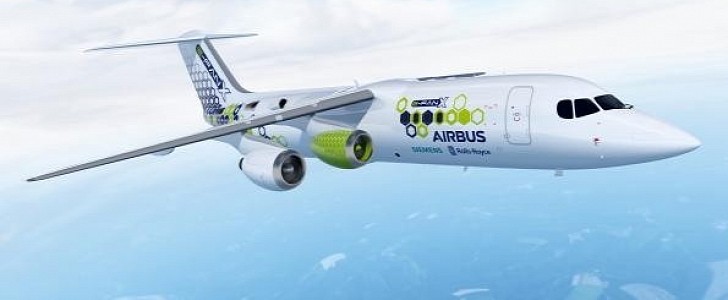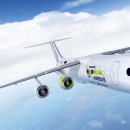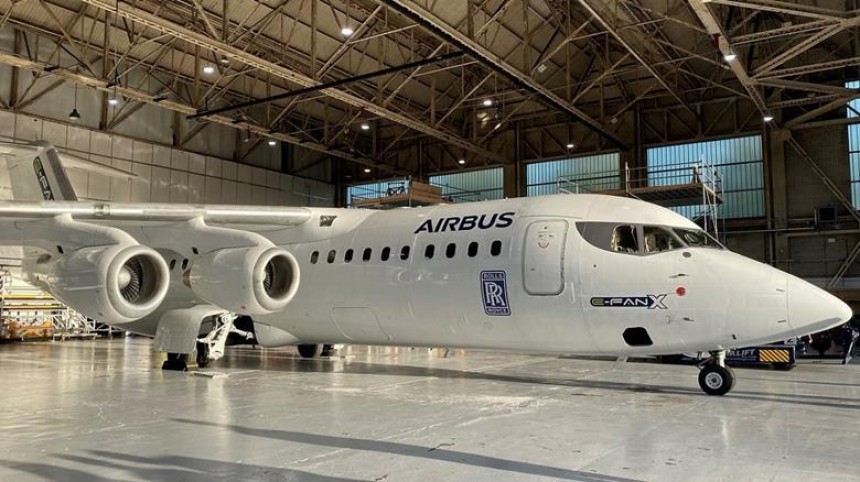As we've said here before, electric aircraft are a completely different ballgame compared to electric cars, at least as far as engineering is concerned. Because weight is the sworn enemy of battery EVs, electric airplane designs that manage to be built often end up on the smaller, personal aviation side of things.
But not the Airbus E-Fan X airliner project. At least, that's what was supposed to happen. Instead, the E-Fan X project had all the momentum of a snail forced to take a detour across the Bonneville Salt Flats from the word go. Just for some fun, let's take a look at the recent electric jet airliner project that looked like the first step to sustainable electric civil aviation.
The reason why the E-Fan X project failed had nothing to do with a lack of ambitious technology. In short, it's very easy to associate the E-Fan X as being a bit like the original Tesla Roadster of the sky. Why? Well, in the same way, the Tesla had a bare shell and chassis derived from a Lotus Elise, the airframe that was to be Airbus' new testbed would not be a bespoke design.
The design in question is British in origin, a British Aerospace (BAe) 146 quad-engined regional airliner. In the standard dyno-juice powered BAe, its quad jet engines, either from Lycoming or Honeywell, produce around 6,990 pounds of thrust (31.1 kN) combined. Now, it's pretty well understood how traditional jet engines work. But what makes the E-Fan X's powerplant so special profoundly changes the very catalyst that allows turbofan jets to operate and still offer power figures nearly identical to that of its normal form.
The plan, at least originally, was to begin by replacing one of the aircraft's inboard engines with a unique electric motor capable of a remarkable 3,400 horsepower, or 2.5 megawatts. The system was to be used in tandem with a Rolls-Royce AE2100 turboshaft engine via a Siemens DC to AC power converter to direct air through the blades of the jet's turbines, almost like a propeller, to increase total output thrust to industry standard levels. The engine was to use a combination of supercritical carbon dioxide and aerospace quality mineral oil in its cooling system.
Over time, it was hoped that one electric-jet hybrid engine would be joined by a second one on the other side of the aircraft. Ambitions for the first flight in 2020 seemed at least somewhat viable when the project was announced at the Royal Aeronautical Society in London on November 28th, 2017. Airbus had already manufactured an electrically powered ducted fan two-seater airplane simply called the E-Fan in 2014. It even crossed the English Channel.
Airbus engineers reckoned some sort of "mild hybrid" alternative to a fully electric vehicle would make any soft transition from petroleum to sustainable energy sources more palatable for global airlines. Potentially dirty sources of said electric energy notwithstanding, of course. Many engineering dilemmas have been solved by direct injections of this magical stuff called money over the years. Meaning that if the E-Fan X design was successful, it had the potential to fund cost-effective and reliable fully EV regional civil airliners.
But like so many all-electric concept vehicles over the last 40 years, months passed, followed by years, and by 2019, the first tentative flight of the E-Fan X was pushed from early 2020 deep into 2021. There's a sense sometimes when engineering projects start to get hit with delays that they're more or less a sign that said project's days are numbered. Although in this case, it's not for a reason typical of the norm.
As with just about everything in the year 2020, that year's global health crisis brought work on the project to a complete halt. Shortly thereafter, the health crisis was used as justification to cancel the project outright. The single BAe 146 slated for conversion to hybrid-electric was never completed. Only a few small-scale wind tunnel models and one full-sized mock-up ever saw the light of day.
It's important to understand that the Airbus E-Fan X was never intended to be put into production. Rather, it was to be a technology demonstrator for hybrid-EV jet engine technology. But even by those lowered expectations, the program had the impact in the civil aviation space of a wet piece of spaghetti. But this abrupt end of the E-Fan X was not the end of Airbus in the EV aircraft niche.
The Airbus-funded EcoPulse project, aimed at EV airplanes of a private and smaller variety than an airliner, is set to take to the skies for the first time this year. It's a design that no doubt draws a few parallels between itself and the E-Fan X. Not the least of which is the company that designed them.
Check back for more from EV month right here on autoevolution.
The reason why the E-Fan X project failed had nothing to do with a lack of ambitious technology. In short, it's very easy to associate the E-Fan X as being a bit like the original Tesla Roadster of the sky. Why? Well, in the same way, the Tesla had a bare shell and chassis derived from a Lotus Elise, the airframe that was to be Airbus' new testbed would not be a bespoke design.
The design in question is British in origin, a British Aerospace (BAe) 146 quad-engined regional airliner. In the standard dyno-juice powered BAe, its quad jet engines, either from Lycoming or Honeywell, produce around 6,990 pounds of thrust (31.1 kN) combined. Now, it's pretty well understood how traditional jet engines work. But what makes the E-Fan X's powerplant so special profoundly changes the very catalyst that allows turbofan jets to operate and still offer power figures nearly identical to that of its normal form.
Over time, it was hoped that one electric-jet hybrid engine would be joined by a second one on the other side of the aircraft. Ambitions for the first flight in 2020 seemed at least somewhat viable when the project was announced at the Royal Aeronautical Society in London on November 28th, 2017. Airbus had already manufactured an electrically powered ducted fan two-seater airplane simply called the E-Fan in 2014. It even crossed the English Channel.
Airbus engineers reckoned some sort of "mild hybrid" alternative to a fully electric vehicle would make any soft transition from petroleum to sustainable energy sources more palatable for global airlines. Potentially dirty sources of said electric energy notwithstanding, of course. Many engineering dilemmas have been solved by direct injections of this magical stuff called money over the years. Meaning that if the E-Fan X design was successful, it had the potential to fund cost-effective and reliable fully EV regional civil airliners.
But like so many all-electric concept vehicles over the last 40 years, months passed, followed by years, and by 2019, the first tentative flight of the E-Fan X was pushed from early 2020 deep into 2021. There's a sense sometimes when engineering projects start to get hit with delays that they're more or less a sign that said project's days are numbered. Although in this case, it's not for a reason typical of the norm.
It's important to understand that the Airbus E-Fan X was never intended to be put into production. Rather, it was to be a technology demonstrator for hybrid-EV jet engine technology. But even by those lowered expectations, the program had the impact in the civil aviation space of a wet piece of spaghetti. But this abrupt end of the E-Fan X was not the end of Airbus in the EV aircraft niche.
The Airbus-funded EcoPulse project, aimed at EV airplanes of a private and smaller variety than an airliner, is set to take to the skies for the first time this year. It's a design that no doubt draws a few parallels between itself and the E-Fan X. Not the least of which is the company that designed them.
Check back for more from EV month right here on autoevolution.







